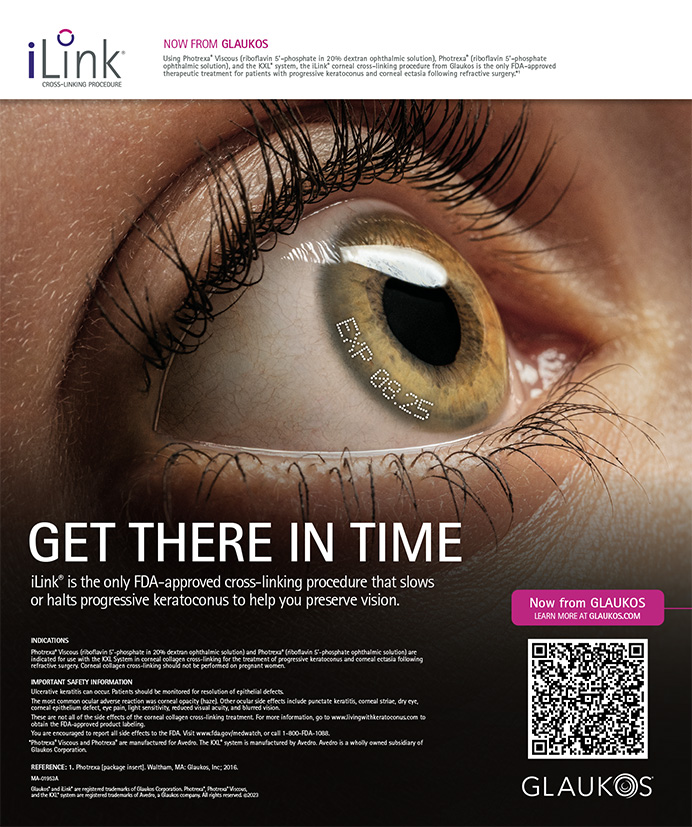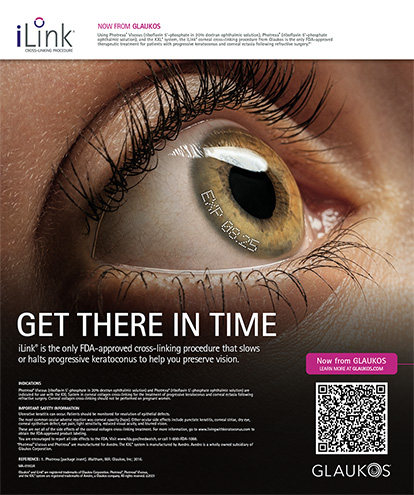When I opened my laser refractive practice in the fall of 1998, my threshold for performing enhancements was relatively high. Perhaps that stemmed from my past experience with the difficulty of performing Russian (front cutting) RK enhancements in the early 1990s. Later, early LASIK surgeons debated whether to recut a new flap or simply lift the existing flap (I always lifted the original). I performed my first “low-threshold” LASIK enhancement on my front desk receptionist, who was vehemently unhappy with her plano -0.75 × 090 LASIK result in her dominant right eye. Her result was essentially plano, and once again, she became a pleasant receptionist. Ever since this outcome, I seriously consider all enhancement requests.
ENHANCEMENT POLICY
I have never agreed with promoting LASIK through free enhancements for life. My policy has always been free enhancements for the first year, then a 50% price reduction thereafter. Here is why:
- The 1-year policy is sufficient and clearly demonstrates that I stand behind my results. A longer period means “free eye care and free eye examinations for life” to many patients. In this scenario, I would be responsible for every patient's foreign body sensation for eternity.
- If enhancements are free, the patient does not have “skin in the game,” and there is no downside to his or her requesting potentially unnecessary surgery.
- Technology and costs change, so it is difficult to define upfront what type of enhancements I will provide for life.
- LASIK patients will always return because they cannot get a better deal elsewhere. This was very helpful in a down LASIK economy, and now, many who are in their 60s still seek my services for cataract surgery.
ENHANCEMENT CONSIDERATIONS
Patient's Age
Unless they are hyperopic, presbyopes rarely require bilateral enhancements. Typically, one eye works well for monovision, and it just takes a little one-on-one time to show the patient that he or she could not read if both eyes were corrected for distance. For a presbyopic patient with a refraction of -0.50 -0.50 × 180 = 20/25+ who wants plano in the distance eye, I give this blackjack analogy: You are holding 20 in your hand now. Do you want me to hit you?
If all other factors are normal, I will typically enhance all complaining patients aged 40 or younger for residual myopia of -0.50 D or higher, astigmatism of 0.75 D or above, or symptomatic hyperopia.
Ocular Dominance
In most situations, patients do not complain about their LASIK results as long as their dominant eye sees at least 20/20. I therefore do what is necessary and possible to achieve this result.
Patients' Expectations and Visual Requirements
Some patients have completely unrealistic expectations. A post-LASIK 60-year-old may not understand why his near and distance vision cannot be like that of a 20-year-old. I have, however, performed an enhancement to please a 30-year-old airline pilot, post-PRK, whose visual acuity was 20/15 in his dominant eye with +0.25 D sphere and who complained that the 20/25+ (-0.50 D sphere) in his other eye was not tolerable.
Patients' Demeanor
If I sense that a presbyopic patient with a result of -0.75 D sphere considers me to be incompetent because I did not obtain perfection the first time, he will be even more disappointed if I do not achieve perfection the second time. I will not touch these patients. Instead, I will prescribe single-vision glasses for nighttime driving.
Degree of Predictability
Factors that decrease the degree of an enhancement's predictability relate to the previous surgery. The incidence of epithelial ingrowth doubles when performing an enhancement. Reportedly, the incidence of visually significant epithelial ingrowth is about 1% in primary cases and 2% on enhancement cases in microkeratome-assisted flap creation.1,2 This incidence appears to decrease after femtosecond-assisted flap creation.3,4 In my experience, lifting previous LASIK flaps prior to an enhancement is also associated with a higher incidence of residual astigmatism.
The type of previous surgery can determine the degree of predictability of the outcome. For instance, I find the greatest predictability with enhancements is with Intralase-created flaps (Abbott Medical Optics Inc.), followed by those made with the Hansatome (Bausch + Lomb) and automated lamellar keratoplasty. PRK over PRK appears to be as predictable as an enhancement under an Intralase flap. PRK over RK, however, can be highly variable based on the quality of the first refractive procedure and existing hypertrophic scarring. Based on my observations, PRK over LASIK can also produce highly variable results, but they tend to improve over several months. If PRK over LASIK is the only option due to a thin stromal bed or folds in a thin LASIK flap, then I believe mitomycin C should be applied topically. The same is true for PRK over RK.
If the previous LASIK surgery was performed with a microkeratome at high altitude, thin flaps are likely; they may be partial, dangerously thin, or even buttonholed. It may be best to perform PRK over the LASIK flap or to obtain an optical coherence tomography scan to ensure the flaps are sufficiently thick prior to lifting them for a LASIK enhancement (Figure).
It has been well established that performing LASIK with a microkeratome over previous PRK is not recommended due to the higher likelihood of buttonholing over an already flattened central cornea. In theory, Intralase LASIK over PRK would not encounter this problem, but it might induce corneal haze. I always perform PRK enhancements over previous PRK.
Not infrequently, I am approached by a presbyopic patient who underwent automated lamellar keratoplasty with nasal flaps more than 10 years ago and now needs the correction of 1.00 D or less. As long as the patient understands that I may have to relift the flaps to remove epithelial ingrowth within a month or to re-treat residual astigmatism after 3 months, then I think the enhancement is worthwhile.
Quality of Previous LASIK
I have noticed that patients from one surgeon (who rarely performs enhancements) typically have partial, decentered, or double flaps, all of which make LASIK enhancements more unpredictable and at greater risk for epithelial ingrowth. In one case (Figure), a 45-year-old patient had -1.50 D of sphere in his dominant right eye and +1.25 D sphere in his left eye. On topography, the ablation zone appeared slightly uneven in the right eye, with more treatment on the bottom three-quarters of the ablation. At the slit lamp, there was a small, superficial temporal corneal scar. Suspecting a partial flap in the right eye, I elected to perform PRK enhancements on both eyes. During the epithelial removal process with the Amoils brush (Innovative Excimer Solutions Inc.), the torn, supratemporal flap edge lifted but was easily replaced prior to PRK. Postoperatively, the patient experienced overcorrection resulting in +1.00 D sphere in the right eye; his left eye was -1.00 D sphere as intended for monovision. No doubt, the patient was just as unhappy as he was preoperatively until approximately 6 months elapsed when his overcorrection resolved in the right eye (he wore a soft contact lens until that time).
KERATOMETRY, CORNEAL PACHYMETRY, AND TOPOGRAPHY
Surgeons should always be careful not to flatten the cornea so that the keratometry readings become less than 35.00 D or the corneal bed decreases to less than 250 μm. In patients under 30 years of age, I make sure that the resulting bed is at least 300 μm, because they are known to have a higher propensity toward ectasia than older patients.
I am careful to rule out ectasia by topography prior to performing any enhancement.
THE FUTURE OF ENHANCEMENTS
As soon as topography-guided PRK becomes widely available in the United States, the range of enhancements will expand from merely treating residual refractive errors to addressing postsurgical pathology and complications such as decentered ablations, highly irregular astigmatism, and postkeratoplasty astigmatism. When the FDA approves corneal collagen crosslinking, I expect that the applications of topography-guided laser surgery will grow to include the correction of post-LASIK ectasia and keratoconus.
Craig Beyer, DO, is the owner and medical director of BoulderEyes/ Beyer Laser Center in Boulder, Colorado. He acknowledged no financial interest in the products or companies mentioned herein. Dr. Beyer may be reached at cbeyer@bouldereyes.com.
- Wang MY, Maloney RK. Epithelial ingrowth after laser in situ keratomileusis. Am J Ophthalmol. 2000;129(6):746-751.
- Asano-Kato N, Toda I, Hori-Komai Y, et al. Epithelial ingrowth after laser in situ keratomileusis: clinical features and possible mechanisms. Am J Ophthalmol. 2002;134(6):801-807.
- Kamburoglu G, Ertan A. Epithelial ingrowth after femtosecond laser-assisted in situ keratomileusis. Cornea. 2008;27(10):1122-1125.
- Letko E, Price MO, Price FW Jr. Influence of original flap creation method on incidence of epithelial ingrowth after LASIK retreatment. J Refract Surg. 2009;25(11):1039-1041.


